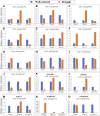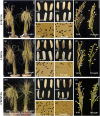Impact of Pre-Anthesis Drought Stress on Physiology, Yield-Related Traits, and Drought-Responsive Genes in Green Super Rice
- PMID: 35401708
- PMCID: PMC8987348
- DOI: 10.3389/fgene.2022.832542
Impact of Pre-Anthesis Drought Stress on Physiology, Yield-Related Traits, and Drought-Responsive Genes in Green Super Rice
Abstract
Optimum soil water availability is vital for maximum yield production in rice which is challenged by increasing spells of drought. The reproductive stage drought is among the main limiting factors leading to the drastic reduction in grain yield. The objective of this study was to investigate the molecular and morphophysiological responses of pre-anthesis stage drought stress in green super rice. The study assessed the performance of 26 rice lines under irrigated and drought conditions. Irrigated treatment was allowed to grow normally, while drought stress was imposed for 30 days at the pre-anthesis stage. Three important physiological traits including pollen fertility percentage (PFP), cell membrane stability (CMS), and normalized difference vegetative index (NDVI) were recorded at anthesis stage during the last week of drought stress. Agronomic traits of economic importance including grain yield were recorded at maturity stage. The analysis of variance demonstrated significant variation among the genotypes for most of the studied traits. Correlation and principal component analyses demonstrated highly significant associations of particular agronomic traits with grain yield, and genetic diversity among genotypes, respectively. Our study demonstrated a higher drought tolerance potential of GSR lines compared with local cultivars, mainly by higher pollen viability, plant biomass, CMS, and harvest index under drought. In addition, the molecular basis of drought tolerance in GSR lines was related to upregulation of certain drought-responsive genes including OsSADRI, OsDSM1, OsDT11, but not the DREB genes. Our study identified novel drought-responsive genes (LOC_Os11g36190, LOC_Os12g04500, LOC_Os12g26290, and LOC_Os02g11960) that could be further characterized using reverse genetics to be utilized in molecular breeding for drought tolerance.
Keywords: anthesis; correlation; drought; drought-responsive genes; grain yield; pollen fertility.
Copyright © 2022 Ahmad, Zafar, Naeem, Shokat, Inam, Rehman, Naveed, Xu, Li, Ali and Khan.
Conflict of interest statement
The authors declare that the research was conducted in the absence of any commercial or financial relationships that could be construed as a potential conflict of interest.
Figures










Similar articles
-
Plant breeding and drought in C3 cereals: what should we breed for?Ann Bot. 2002 Jun;89 Spec No(7):925-40. doi: 10.1093/aob/mcf049. Ann Bot. 2002. PMID: 12102518 Free PMC article. Review.
-
Root and canopy traits and adaptability genes explain drought tolerance responses in winter wheat.PLoS One. 2021 Apr 5;16(4):e0242472. doi: 10.1371/journal.pone.0242472. eCollection 2021. PLoS One. 2021. PMID: 33819270 Free PMC article.
-
Screening of Bread Wheat Genotypes for Drought Tolerance Using Phenotypic and Proline Analyses.Front Plant Sci. 2016 Aug 25;7:1276. doi: 10.3389/fpls.2016.01276. eCollection 2016. Front Plant Sci. 2016. PMID: 27610116 Free PMC article.
-
Genome-Wide Association Study for Yield and Yield Related Traits under Reproductive Stage Drought in a Diverse indica-aus Rice Panel.Rice (N Y). 2020 Aug 6;13(1):53. doi: 10.1186/s12284-020-00406-3. Rice (N Y). 2020. PMID: 32761553 Free PMC article.
-
Staying Alive or Going to Die During Terminal Senescence-An Enigma Surrounding Yield Stability.Front Plant Sci. 2015 Nov 30;6:1070. doi: 10.3389/fpls.2015.01070. eCollection 2015. Front Plant Sci. 2015. PMID: 26648957 Free PMC article. Review.
Cited by
-
The comparative transcriptome analysis of two green super rice genotypes with varying tolerance to salt stress.Mol Biol Rep. 2023 Dec 18;51(1):22. doi: 10.1007/s11033-023-08998-x. Mol Biol Rep. 2023. PMID: 38110786
-
Effect of Qiangdi 863 Nanosynergids Treated Water, Nitrogen, Phosphorous and Potassium Fertilizers on Rice Growth Physiology and Grain Quality.Front Plant Sci. 2022 Jul 14;13:916949. doi: 10.3389/fpls.2022.916949. eCollection 2022. Front Plant Sci. 2022. PMID: 35909737 Free PMC article.
-
Identification of a novel mutation in the OsMRP5 gene in low phytate Basmati rice mutant and development of CAPS marker for marker-assisted breeding.Front Plant Sci. 2024 Dec 17;15:1455219. doi: 10.3389/fpls.2024.1455219. eCollection 2024. Front Plant Sci. 2024. PMID: 39741669 Free PMC article.
-
Mitigation of water scarcity with sustained growth of Rice by plant growth promoting bacteria.Front Plant Sci. 2023 Jan 23;14:1081537. doi: 10.3389/fpls.2023.1081537. eCollection 2023. Front Plant Sci. 2023. PMID: 36755700 Free PMC article.
-
A detailed study on genetic diversity, antioxidant machinery, and expression profile of drought-responsive genes in rice genotypes exposed to artificial osmotic stress.Sci Rep. 2023 Oct 26;13(1):18388. doi: 10.1038/s41598-023-45661-8. Sci Rep. 2023. PMID: 37884634 Free PMC article.
References
-
- Ahmed S., Rashid M. A. R., Zafar S. A., Azhar M. T., Waqas M., Uzair M. (2021). Genome-wide Investigation and Expression Analysis of APETALA-2 Transcription Factor Subfamily Reveals its Evolution, Expansion and Regulatory Role in Abiotic Stress Responses in Indica Rice (Oryza Sativa L. Ssp. Indica). Genomics 113 (1 Pt 2), 1029–1043. 10.1016/j.ygeno.2020.10.037 - DOI - PubMed
-
- Bajji M., Kinet J.-M., Lutts S. (2002). The Use of the Electrolyte Leakage Method for Assessing Cell Membrane Stability as a Water Stress Tolerance Test in Durum Wheat. Plant Growth Regul. 36 (1), 61–70. 10.1023/A:1014732714549 - DOI
-
- Barker R., Dawe D., Tuong T., Bhuiyan S., Guerra L. (1999). The Outlook for Water Resources in the Year 2020: Challenges for Research on Water Management in rice Production. Southeast Asia 1, 1–5.
-
- Blum A., Ebercon A. (1981). Cell Membrane Stability as a Measure of Drought and Heat Tolerance in Wheat 1. Crop Sci. 21 (1), 43–47. 10.2135/cropsci1981.0011183x002100010013x - DOI
LinkOut - more resources
Full Text Sources

